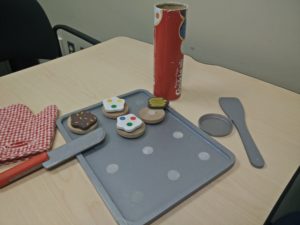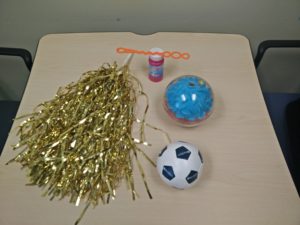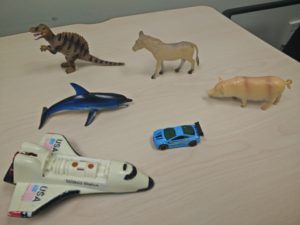Main Body
7 Plan C: Non-standardized assessment
Learning Objectives
- Learn ways of evaluating developmental level and aspects of cognitive functioning when it is not possible to complete a standardized measure.
- Understand the importance of communication evaluation in children with multiple, severe disabilities.
Creative approaches to non-standardized assessment
Some children are not able to participate in a standardized measure of intelligence or a standardized measurement of developmental level.
For children like Susan, it would be appropriate to take a different approach to assessment. This could include using individual items from developmental assessment measures (e.g., the Bayley-4), play-based interactions to evaluate discrete cognitive functions, structured or unstructured observation, and interview. This type of “non-standardized” assessment can be used when no standardized assessment is possible, or can be used to augment a standardized assessment.
Below I describe two approaches which are useful as models of how to evaluate a child’s learning processes rather than evaluate discrete cognitive skills. These models are also very useful for helping support children in their development (next steps).
- Child Guided Assessment by Jan van Dijk was originally designed for working with children who are Deafblind. This approach encourages the examiner to look at the processes through which the child learns, rather than evaluate discrete skills. The foundation of the assessment relies on the assessor establishing a relationship with the child. The child’s interests and abilities determine what materials are used to promote the child’s engagement. The focus of the report/feedback is on identifying strengths and next steps in development. Child-guided strategies are “conversational.” Establishing an interactive routine is important. To do this, the assessor may imitate what the child is doing, then add new information. Communicative signals are elicited by stopping the routine and waiting for a signal from the child indicating a desire for continuation. Excellent video examples of this approach are available in the Resources for Further Education section below.
- Sensori-motor learning by Millie Smith is designed to help learners move through hierarchical states/stages. This model recognizes that some children spend periods of time in what Smith calls “extended states” where they are sleepy or agitated. The goal would be to help them achieve and maintain focus on objects to promote learning. There are a series of objects available which help stimulate the child’s various senses to see what they respond to. The next goal would be to help the child explore objects through their available senses. This would then move to understanding the function of objects and then learning to label objects. The goal is developing “Coherence” – the feeling that you understand what is going on in your environment.
- Active learning by Lili Nielsen is an approach for assessment and curriculum for children with multiple, severe disabilities. The Functional Scheme Assessment provides a structure to evaluate functioning across areas in order to develop an appropriate learning plan.
The models above can be complemented with an evaluation of the child’s developmental functioning in various domains. The remainder of this chapter is devoted to discussing how to do this in a child who cannot complete a standardized test. Evaluation of socio-emotional development and behaviour will be discussed in a separate chapter.
Communication
Communication is often THE most important area to address for children with severe disabilities. It is essential for quality of life: choice making, social relationships, reducing frustrated behaviour, etc. If you are lucky enough to have a speech and language pathologist as part of your team, their assessment will provide an in depth look at communication. When you are looking at communication, look both for the goal of the communication, and the mode of communication (see the table below). To learn more about assessing and supporting children with complex communication needs, see the Communication Matrix, a free online tool available at https://communicationmatrix.org/.
| Goal of communication | Modes of communication |
|
|
Assessment of communication
- Is the child able to communicate essential needs such as hunger, thirst, and pain?
- Is the child able to make choices when provided with 2 or more options? For example, would they consistently “choose” what is clearly the preferred choice (e.g., favorite TV show or favorite food)?
- Can they reliably respond yes and no, and in what mode?
- Do they understand or use any gestures (e.g., point to indicate desire, arms up to request “up”)?
- Do they have finger/hand use sufficient for basic sign language use? Try to teach a simple sign (e.g., “more” in relation to requesting food).
- Does the child recognize any visual communication symbols such as symbols or signs (e.g., recognize McDonalds arches, sign for bus stop).
- Can they discriminate between different drawings or photos of objects? If they cannot do either, they may need real objects to make choices (basketball to symbolize the gym).
- Can the child follow a one step instruction in a routine situation (e.g., “put your arms up” when dressing)? Can they follow a one step instruction when outside of a familiar routine (e.g., saying “put your arms up” during the assessment)? Do they need a visual prompt or can they follow a request with a verbal prompt only? In order to directly assess this, try incorporating commands into play or natural conversation. Be careful to observe what cues the child uses such as watching your eye movements or reading gestures. For example, you could ask, “Please put your napkin in the garbage.”
General cognitive functions
- Can you elicit object permanence? Do they look for an object placed out of sight or dropped on the floor?
- Can the child understand cause/effect reasoning. Simple cause and effect reasoning would be something like – press a button to make a toy pop up, flip on a light switch and watch the light turn on.
- Does the child understand the function of common objects? For example, puts spoon in mouth, puts hat on head.
- Do you observe imitation/attempted imitation? For example, introduce a novel toy and show how it works. Are they able to reproduce this? Put a toy on your head, do they copy you?
- What kind of problem solving can the child demonstrate? For example – puts together a 2 piece puzzle, gets something out of a container, stacks cups, takes something out of a bag.
- Play skills: level of play provides insight into developmental level. A broad developmental trajectory would be mouthing, banging, throwing/dropping, shaking, functional play (play with a toy as it is intended), parallel play, make believe play, cooperative play. However, be aware that children with severe motor or sensory disorders have had a different developmental experience than typical children. They may be less interested in, or less experienced with play.
Learning/Memory
- Is the child able to show habituation to repeated/familiar stimuli?
- What do they show memory for? Familiar people, places, objects? Get examples from everyday life. Do they react differently to familiar vs unfamiliar people? Having a favorite toy would be an example of memory for an object.
- Can the child predict what will happen if you repeat the same action multiple times? For example, do they know what to expect next in their familiar daily routines? If they go to the bus stop, do they get excited because they know they will be getting on the bus? Do they react to a mismatch to expectations? One fun way to test this is to put an object like a doll on your head and pretend to “sneeze” with a slow lead up to a big “achoo” where the doll flies off your head. Does the child start to predict this will happen and get excited?
- You can use things from a backpack that the child recognizes: present the items, remove, hide them etc.
- Learning from experience (trying something new). For example, find something new and teach it, and see if they remember it later. Many children have difficulty putting together two small triangles to make a large triangle on the Stanford Binet-5 puzzle. Teach them, then present it again later. Follow up – Will they apply their learning to new situations?
- Can the child hold information in mind briefly (“short term memory”)? For example, hide a toy of interest or food under a cup. Increase the difficulty level by using multiple cups, move the toy/food to a new cup (visible displacement – “look I’m moving it here”), or switch the location by moving cups while toy/food is hidden (hidden displacement). There is a series like this on the Bayley-III.
Early academic assessment – reading. Is the child able to:
- Recognize any signs and symbols in the community (e.g., McDonalds; boys vs girls washroom)?
- Listen attentively to a short story?
- Recognize that a book is held a certain way.
- Recognize that words on the page are associated with spoken words.
- Recognize rhymes (do they enjoy rhyming songs, word plays?).
- Provide rhymes for words, e.g., fly, star.
- Recognize letters (i.e., which one is the “A”?). For many children, most likely they would recognize the first letter of their name.
- Name letters (presented one by one vs. in the context of a word or sentence).
- Name letter sounds.
- Recognize own first name written (provide choice of 3, can they point to it?) May want to try with printing three/four names on individual pieces of paper and ask them to pick up their name.
- Recognize sight words (may use enlarged version or whiteboard).
Early academic assessment – writing. Is the child able to:
- Hold a writing utensil (can they use a pencil/pen or do they need a marker?).
- Scribble purposefully.
- Connect dots; trace shapes.
- Copy shapes from model (line, circle, triangle) – may want to try doing the Beery VMI.
- Trace letters (e.g., of their first name).
- Copy first name from a model.
- Write letters or words to dictation.
- Speak clearly enough to use speech-to-text technology?
Early academic assessment – math. Is the child able to:
- Match by shape or colour.
- Recognize (point to) shapes/colours, name shapes/colours.
- Understand patterns using real objects XOXO pattern? (2 step, 3 step).
- Understand printed patterns XOXO..?
- Understand concepts such as more/less, up/down, empty/full, longest/shortest, same/different.
- Recognize written numbers.
- Able to answer questions about number concepts (e.g., how many brothers do you have? If we were setting the table for everyone in your family, how many plates would you need?).
- Count aloud; Count concrete objects aloud with 1:1 correspondence moving one at a time; concrete objects without moving them; count objects drawn on paper.
- Identify which group has a certain number of items.
- Understand concept of “1 more” (concrete, abstract).
Creative assessment requires creative tools! Here are some ideas:
- 2 or 3 large plastic cups to hide object under (e.g., from SB-5).
- 3 piece puzzle (e.g., triangle, square, circle from the SB-5 to assess visual spatial skills and problem solving).
- Toy cookie making set (to assess play skills, numeracy, ability to follow directions, social skills).
- Toys that assess cause and effect reasoning (press a button, something happens) especially those that light up or make sound.
- Large portable white board & marker (to assess letter recognition, name recognition, simple math).
- Shapes of different colors (to assess color/shape recognition and pattern recognition, “let’s put away all the yellow ones!”).
- A few items to assess recognition (e.g., spoon, pencil, ball, cup).
- Soft, squishy, easy to catch ball (to assess play skills, following directions, coordination).
- Snacks/treats and favorite objects brought from child’s home to use as motivation.
- Printed pictures/photos of objects/actions.
- Toys that promote creative play (e.g., dolls, figures, house cars).
- Objects/toys that involve sensory stimulation (make noise, have lights/shiny things, vibrate).
- Wiki sticks, thick crayons, triangular pencil, heavy black pen, thick lined paper.
- Balls of different textures, bounciness, weight and shape (e.g., white Styrofoam cube).
- Large magnetic letters plus magnet board.
- Developmental assessment kits (e.g., Bayley-4) have a lot of good items to use.



Key Takeaways
- Non-standardized assessment is appropriate when a child is not able to complete any standardized measures. It can also be used to supplement standardized assessment.
- Non-standardized assessment may include:
- Administration of individual items from standardized measures (e.g., SB-5 puzzle, items from the Bayley-4).
- Play-based structured interactions.
- Directly attempting to engage the child in demonstrating specific skills.
- Observation of the child.
Resources for Further Education
- Child Guided Assessment:
- Nelson, C., Dijk, J. McDonnell, A.P. & Thompson, K. (2002). A Framework for Understanding Young Children with Severe Multiple Disabilities: The Van Dijk Approach to Assessment. Research and Practice for Persons with Severe Disabilities, 27(2), 97-111.
- For an excellent case-based example of how to use this approach in assessment see this article.
- CD-ROM: Child-Guided Strategies for Assessing Children who are Deafblind or have Multiple Disabilities, sold by the American Printing House for the Blind ($60).
- A 30 minute video summary can be found for free here: http://www.perkinselearning.org/videos/webcast/child-guided-assessment
- Sensori-motor learning: Free video with Millie Smith: “Strategies for Assessing and Teaching Students with Visual and Multiple Disabilities” http://www.perkinselearning.org/videos/webcast/strategies-assessing-and-teaching-students-visual-and-multiple-disabilities
- Active learning: http://www.activelearningspace.org/ has a series of free online courses on this approach.

